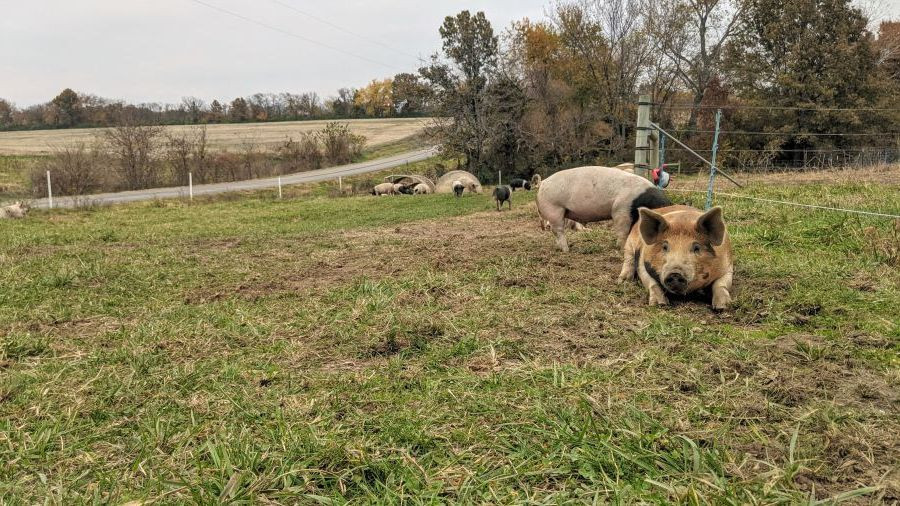The Positive Impacts of Intensive Rotational Grazing
posted on
October 26, 2023
Are you curious about sustainable farming practices that not only benefit our environment but also result in healthier, happier cattle? Intensive rotational grazing is a remarkably simple technique that accomplishes just that. In this blog post, I'll share the positive impacts of intensive rotational grazing, shedding light on why it's a win-win for consumers, farmers, and our planet.
What Is Intensive Rotational Grazing?
Before we dive into the benefits, let's understand what intensive rotational grazing is. This method involves carefully managed grazing cycles where the cattle are quickly rotated through smaller sections of pasture, allowing the grazed areas time to recover. This rest period lets the grass regrow and thrive, ensuring a consistent supply of high-quality forage. Our rotational grazing here at DP involves, weekly, daily, or even twice daily rotations, depending on the time of year.
1. Healthier Cattle
Intensive rotational grazing translates to healthier and happier cattle. Here's how:
- Nutrient-Rich Forage: The rest periods allow grasses to grow taller and more nutritious. This means that cattle have access to better-quality forage, leading to improved nutrition and overall well-being.
- Reduced Disease Risk: Rotating often and grazing taller grasses means less exposure to parasites and disease vectors. We do not use antibiotics or other medications in our cattle production, but even if we were okay with that we wouldn't have a reason to; healthy, well-managed cattle have no need for veterinary intervention!
2. Enhanced Biodiversity
Intensive rotational grazing is not only about the cattle but also about fostering biodiversity in the pasture ecosystem. Here's how it contributes to a thriving natural environment:
- Diverse Plant Communities: Intensive grazing reduces competition and encourages a variety of plant species to coexist. This diversity attracts a wider range of insects, birds, and other wildlife, contributing to a healthier ecosystem, as well as a more balanced diet for the cattle grazing it.
- Soil Health: Healthy grasses with strong root systems help prevent soil erosion and compaction by giving providing structure and aeration. This, in turn, improves water infiltration and carbon sequestration, making the soil more resilient and sustainable through flood and drought.
- Integration of Poultry: Rotational grazing allows us to easily integrate pasture-raised poultry into our cattle program. The cattle graze the grass short enough for the poultry to browse, and the poultry clean up the bugs behind the cattle, keeping the pest population in balance.
3. Reduced Environmental Impact
Consumers are increasingly concerned about the environmental footprint of their food. Intensive rotational grazing addresses these concerns effectively:
- Carbon Sequestration: Taller grasses sequester more carbon in their roots and soil, making it a potent tool in combating climate change. Cattle grazing on this forage indirectly contribute to carbon capture and storage. FUN FACT: Healthy pasture can sequester more carbon than forested area. And with intensive rotational grazing, we speed up the process by grazing several times per year and allowing rest periods in between for regrowth.
- Water Quality: Managed grazing systems filter and purify water by retaining more water in the soil, and creating better filtration. This also reduces runoff, and minimizes the impact of livestock operations on nearby bodies of water.
- Better Long-Term Productivity: By managing pastures through intensive rotational grazing, we are promoting a healthier ecosystem that can support our cattle over the long term, ensuring sustained and even increasing productivity. We are able to support more cattle per acre on our farms than we could when we first stared years ago, all thanks to intensive rotational grazing.
How Can You Support Intensive Rotational Grazing?
As consumers, you have the power to encourage regenerative practices by supporting farmers who implement intensive rotational grazing. Many farmers selling "grass-fed" or "pasture-raised" meat and dairy products utilize intensive rotational grazing, but not all, so make sure to ask. These terms are loosely regulated in the US and are often hijacked by companies for marketing purposes. Know your farmer, know your food.
In conclusion, intensive rotational grazing is not just a buzzword; it's a practical and proven approach to farming that benefits us all. It results in healthier, happier cattle, supports biodiversity, and reduces environmental impact. By choosing products from farms that prioritize this method, you are not only enjoying better-quality food but also contributing to a more sustainable and ecologically responsible future.
All of the beef we raise and sell comes from rotationally-grazed cattle who were grass-fed and grass-finished, which means that they never received grain. In addition, our cattle have not been vaccinated or given any medications.
CLICK HERE to order grass-fed beef that you can eat with confidence.
Your farmer,
Remi Kesten



